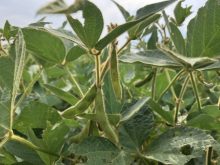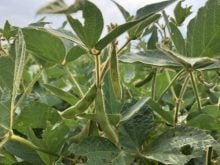Health Canada will not be further regulating the use of dicamba herbicide sprayed on growing crops, as has happened in the U.S.
The government agency that regulates pesticides issued a statement to Glacier FarmMedia reiterating its support for the current Canadian labels.
The U.S. Environmental Protection Agency (EPA) last week increased restrictions on the use of dicamba sprayed over growing crops, after the first season of use of dicamba-resistant soybeans turned up about three million U.S. acres with crop damage.
Read Also

India slaps 30 per cent import duty on yellow peas
India has imposed a 30 per cent duty on yellow pea imports with a bill of lading date on or after Nov. 1, 2025.
There appeared to be a much lower level of damage in Canada, where there was a campaign to encourage farmers to only use the system with pre-plant and pre-emergent timing and where there are fewer herbicide-resistant weed challenges.
The dicamba-resistant system, called Xtend, is licensed and used by Monsanto.
For its part, Monsanto Canada said in an email its Canadian growers’ experience with the Xtend system in 2017 was “overwhelmingly positive,” with “very few” calls from growers, applicators and/or retailers about off-site herbicide movement.
The EPA made application of dicamba over growing crops a “restricted use,” meaning it can only be applied by certain licensed applicators, with special training, or workers under their supervision.
Farmers will have to maintain specific records regarding the use of these products to improve compliance with label restrictions.
Maximum wind speeds allowable for the use of the product have been reduced from 15 to 10 mph (from 24 to 16 km/h) and the time of day of allowable use has been reduced. The EPA has also made more provisions for making sure there aren’t sensitive crops close to where spraying happens and changing language on cleanout of tanks to prevent cross-contamination.
The EPA says it worked with dicamba manufacturers Monsanto, BASF and DuPont on the label changes.
Health Canada is the supervising department for the Pest Management Regulatory Agency, which evaluates and approves pesticides in Canada.
In its statement Health Canada said it is aware of the dicamba drift challenges in the U.S. and “to protect the environment, Health Canada has already mandated that labels of dicamba products include spray drift precautions, use directions and buffer zones. The department is confident that these existing requirements address issues such as those identified in the U.S.”
The Canadian label says optimum application conditions are between five km/h and 16 km/h and contains specific instructions on tank cleanout.
A Monsanto Canada spokesperson last week said no dicamba label changes are currently anticipated from the PMRA. Health Canada said it “will continue to monitor the situation and will take action as necessary.”
Noting crop protection companies in Canada are federally required to report any claims involving adverse effects of pesticides, Monsanto’s spokesperson said data on the Xtend system for the 2017 season so far showed inquiries about product performance, off-target movement and “crop response” involving fewer than 900 acres in all, or about 0.1 per cent of Xtend acres planted across Western and Eastern Canada.
— John Greig is a field editor for Glacier FarmMedia based at Ailsa Craig, Ont. Follow him at @jgreig on Twitter. Includes files from Dave Bedard of AGCanada.com.













